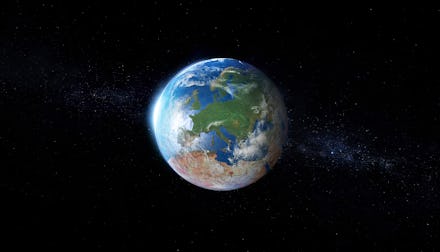Scientists take shots at Earth, say humans can do better than this ball of trash

Many humans, particularly the young ones, have been doing everything they possibly can to ensure that Earth remains habitable. They do this because they, like the rest of us, have to live here, and would like for the planet to not become an inferno of death and misery.
But what if we could do better than Earth? What if there were planets worth ditching this one for? In a new study published this week in the journal Astrobiology, scientists say those planets are out there. The researchers revealed that they have found at least 24 planets considered to be "superhabitable," offering conditions for life as good as, if not better, than what we’ve got on this old trash heap. Of course, it's worth noting that to the best of our knowledge, there are no humans on any of them, which might be a contributing factor as to why they look so good right now.
Superhabitable planets, as identified by the researchers, are planets that meet a host of criteria that suggests they may be capable of supporting lifeforms like humans. The researchers searched for planets that are about 10 percent larger than the Earth, because such size would suggest a greater likelihood of the planet having habitable land. They also sought out planets that had about 1.5 times the mass of Earth, as planets with additional mass are expected to have better interior heating and stronger gravity, which allows it to maintain its atmosphere for a longer period of time than planets with less mass.
The researchers also sought planets that seemed capable of forming water. This is essential to any prospective planet that may one day support life. To determine if one of these distant rocks support the key to life, researchers looked for planets that have a surface temperature slightly higher than Earth’s, by about eight degrees Fahrenheit, which would reflect conditions similar to what is found in tropical rain forests here on our home planet. They also sought out signs of moisture, clouds, and humidity that would suggest water is present.
Finally, researchers looked for a sun near the planet. The Earth's sun is what is known as a G-type main-sequence star, or G dwarf star. And while it gets the job done for us, it's actually not the ideal type of star to have for a sun because it can burn out in just 10 billion years, which is barely enough time for life to develop. It took humans about 4.5 billion years to finally show up on Earth and now the Sun only has about 5 billion years left.
If you're looking to set up a new planet, you want a star that lasts longer than that, which is why scientists looked for K-type main-sequence star, or K dwarf stars. They tend to burn at a little lower temperature, but they have a much longer lifespan, lasting between 20 to 70 billion years. That allows life plenty of time to form.
That said, researchers didn't want a planet that was too old. Earth is actually a bit on the young side compared to the sweet spot for a planet that is going to support complex life. Researchers sought out planets that were between five and eight billion years old, with the idea being that the planet should be mature enough to have developed its protective geomagnetic fields but not so old as to have exhausted its geothermal heat.
In total, researchers identified 24 planets out of more than 4,500 studied that could be classified as superhabitable. However, none of them met all the critical criteria set forth by the scientists, and only one planet checked four or more boxes, making it the clear choice for an ideal Earth alternative. The one problem remaining: it's more than 100 light-years away. That means we might be stuck with Earth after all, so it might be best if we make a concerted effort to care for it. Sure, it's not the ideal planet, but it's the only one we've got.